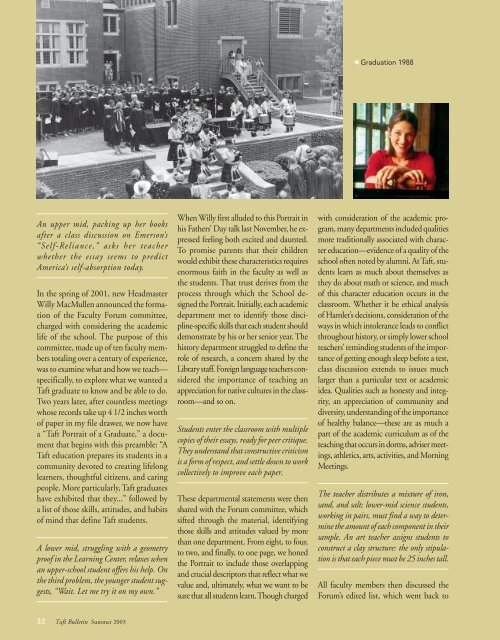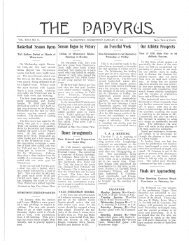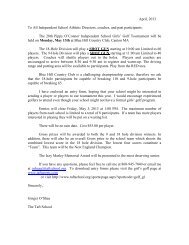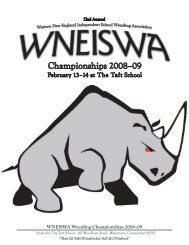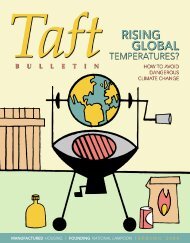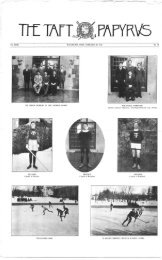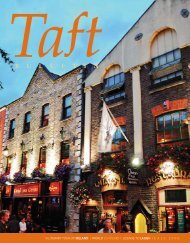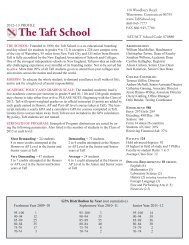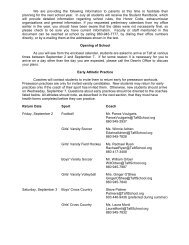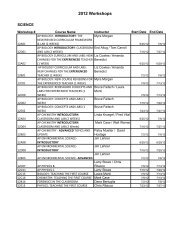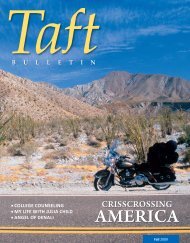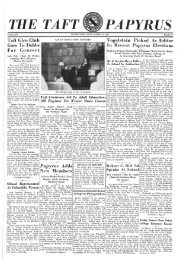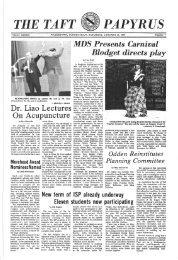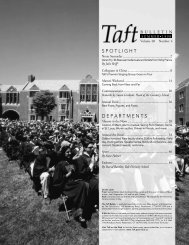B U L L E T I N Taft Portrait of a Graduate - The Taft School
B U L L E T I N Taft Portrait of a Graduate - The Taft School
B U L L E T I N Taft Portrait of a Graduate - The Taft School
- No tags were found...
Create successful ePaper yourself
Turn your PDF publications into a flip-book with our unique Google optimized e-Paper software.
Graduation 1988<br />
An upper mid, packing up her books<br />
after a class discussion on Emerson’s<br />
“Self-Reliance,” asks her teacher<br />
whether the essay seems to predict<br />
America’s self-absorption today.<br />
In the spring <strong>of</strong> 2001, new Headmaster<br />
Willy MacMullen announced the formation<br />
<strong>of</strong> the Faculty Forum committee,<br />
charged with considering the academic<br />
life <strong>of</strong> the school. <strong>The</strong> purpose <strong>of</strong> this<br />
committee, made up <strong>of</strong> ten faculty members<br />
totaling over a century <strong>of</strong> experience,<br />
was to examine what and how we teach—<br />
specifically, to explore what we wanted a<br />
<strong>Taft</strong> graduate to know and be able to do.<br />
Two years later, after countless meetings<br />
whose records take up 4 1/2 inches worth<br />
<strong>of</strong> paper in my file drawer, we now have<br />
a “<strong>Taft</strong> <strong>Portrait</strong> <strong>of</strong> a <strong>Graduate</strong>,” a document<br />
that begins with this preamble: “A<br />
<strong>Taft</strong> education prepares its students in a<br />
community devoted to creating lifelong<br />
learners, thoughtful citizens, and caring<br />
people. More particularly, <strong>Taft</strong> graduates<br />
have exhibited that they...” followed by<br />
a list <strong>of</strong> those skills, attitudes, and habits<br />
<strong>of</strong> mind that define <strong>Taft</strong> students.<br />
A lower mid, struggling with a geometry<br />
pro<strong>of</strong> in the Learning Center, relaxes when<br />
an upper-school student <strong>of</strong>fers his help. On<br />
the third problem, the younger student suggests,<br />
“Wait. Let me try it on my own.”<br />
When Willy first alluded to this <strong>Portrait</strong> in<br />
his Fathers’ Day talk last November, he expressed<br />
feeling both excited and daunted.<br />
To promise parents that their children<br />
would exhibit these characteristics requires<br />
enormous faith in the faculty as well as<br />
the students. That trust derives from the<br />
process through which the <strong>School</strong> designed<br />
the <strong>Portrait</strong>. Initially, each academic<br />
department met to identify those discipline-specific<br />
skills that each student should<br />
demonstrate by his or her senior year. <strong>The</strong><br />
history department struggled to define the<br />
role <strong>of</strong> research, a concern shared by the<br />
Library staff. Foreign language teachers considered<br />
the importance <strong>of</strong> teaching an<br />
appreciation for native cultures in the classroom—and<br />
so on.<br />
Students enter the classroom with multiple<br />
copies <strong>of</strong> their essays, ready for peer critique.<br />
<strong>The</strong>y understand that constructive criticism<br />
is a form <strong>of</strong> respect, and settle down to work<br />
collectively to improve each paper.<br />
<strong>The</strong>se departmental statements were then<br />
shared with the Forum committee, which<br />
sifted through the material, identifying<br />
those skills and attitudes valued by more<br />
than one department. From eight, to four,<br />
to two, and finally, to one page, we honed<br />
the <strong>Portrait</strong> to include those overlapping<br />
and crucial descriptors that reflect what we<br />
value and, ultimately, what we want to be<br />
sure that all students learn. Though charged<br />
with consideration <strong>of</strong> the academic program,<br />
many departments included qualities<br />
more traditionally associated with character<br />
education—evidence <strong>of</strong> a quality <strong>of</strong> the<br />
school <strong>of</strong>ten noted by alumni. At <strong>Taft</strong>, students<br />
learn as much about themselves as<br />
they do about math or science, and much<br />
<strong>of</strong> this character education occurs in the<br />
classroom. Whether it be ethical analysis<br />
<strong>of</strong> Hamlet’s decisions, consideration <strong>of</strong> the<br />
ways in which intolerance leads to conflict<br />
throughout history, or simply lower school<br />
teachers’ reminding students <strong>of</strong> the importance<br />
<strong>of</strong> getting enough sleep before a test,<br />
class discussion extends to issues much<br />
larger than a particular text or academic<br />
idea. Qualities such as honesty and integrity,<br />
an appreciation <strong>of</strong> community and<br />
diversity, understanding <strong>of</strong> the importance<br />
<strong>of</strong> healthy balance—these are as much a<br />
part <strong>of</strong> the academic curriculum as <strong>of</strong> the<br />
teaching that occurs in dorms, adviser meetings,<br />
athletics, arts, activities, and Morning<br />
Meetings.<br />
<strong>The</strong> teacher distributes a mixture <strong>of</strong> iron,<br />
sand, and salt; lower-mid science students,<br />
working in pairs, must find a way to determine<br />
the amount <strong>of</strong> each component in their<br />
sample. An art teacher assigns students to<br />
construct a clay structure: the only stipulation<br />
is that each piece must be 25 inches tall.<br />
All faculty members then discussed the<br />
Forum’s edited list, which went back to<br />
32 <strong>Taft</strong> Bulletin Summer 2003


